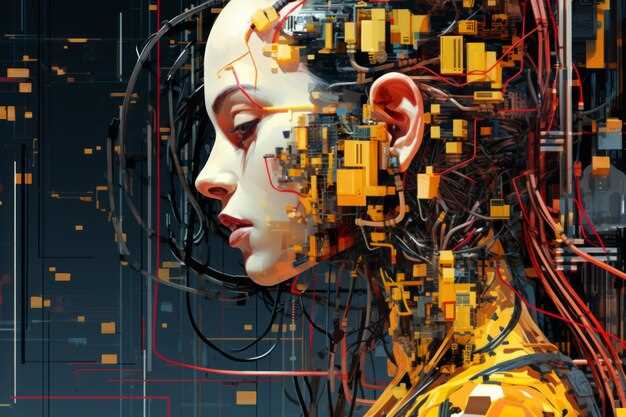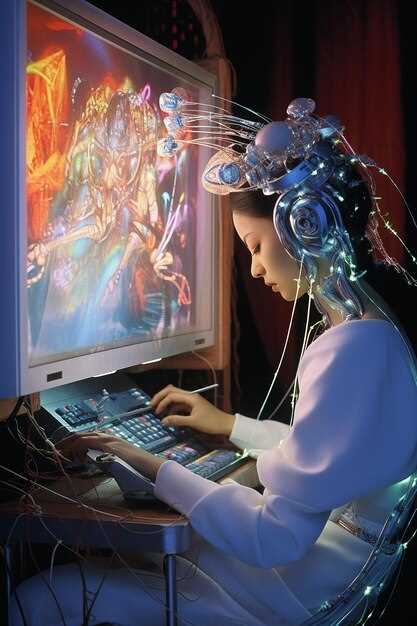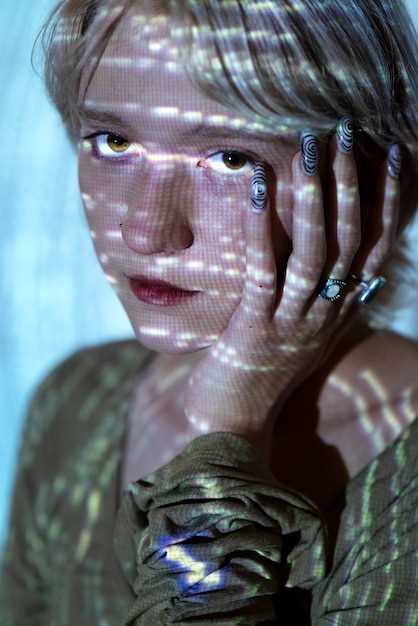
In the ever-evolving landscape of artistic creation, an intriguing synergy has emerged between the realm of artificial intelligence and the avant-garde. This captivating convergence has given birth to a new era of artistic exploration, where the boundaries of human imagination are pushed to their limits. Through the interplay of cutting-edge technology and the boundless depths of human creativity, a mesmerizing tapestry of digital artistry is being woven.
Within this captivating realm, the enigmatic dance between AI and avant-garde expression unfolds. As the digital age continues to shape our world, artists are harnessing the power of artificial intelligence to delve into uncharted territories of artistic innovation. The marriage of these two seemingly disparate realms has birthed a new breed of creators, who are unafraid to challenge convention and redefine the very essence of artistic creation.
With each stroke of the digital brush and every algorithmic composition, a symphony of emotions and ideas is brought to life. The interplay of AI algorithms and human ingenuity gives rise to a harmonious fusion of the tangible and the intangible, the rational and the abstract. This symbiotic relationship between man and machine has opened up a world of possibilities, where the boundaries of artistic expression are expanded beyond what was once thought possible.
Through the lens of AI, the digital canvas becomes a playground for experimentation and exploration. The algorithms, like silent collaborators, assist artists in unraveling the mysteries of their own creativity. As the lines between creator and creation blur, a new form of artistic dialogue emerges, one that transcends the limitations of human perception and embraces the infinite potential of the digital realm.
The Evolution of Artificial Intelligence in the Art World

In this section, we will delve into the dynamic progression of AI within the realm of artistic expression. We will explore how AI has transformed the art world, revolutionizing traditional creative processes and pushing the boundaries of human imagination.
From Traditional to Technological: Redefining Artistic Creation
The advent of artificial intelligence has ushered in a new era of artistic creation, challenging conventional notions of what it means to be an artist. With AI algorithms capable of generating original artworks, the role of the artist has expanded to include collaboration with intelligent machines. This fusion of human creativity and machine intelligence has given rise to a plethora of innovative and thought-provoking artworks that captivate audiences worldwide.
The Emergence of AI as a Creative Tool

AI has not only redefined the role of the artist but has also become an indispensable tool for creative expression. Artists now harness the power of AI to explore new artistic techniques, generate unique visualizations, and experiment with unconventional mediums. By leveraging machine learning algorithms, artists can uncover hidden patterns, extract meaningful insights, and create artworks that challenge traditional artistic norms.
Moreover, AI has enabled artists to explore the uncharted territories of imagination and creativity, pushing the boundaries of what was once thought possible. By utilizing AI-powered tools, artists can transcend the limitations of their own artistic abilities, opening up a world of infinite possibilities and unexplored artistic landscapes.
As AI continues to evolve and advance, it is poised to reshape the art world even further, blurring the lines between human and machine creativity, and inspiring new forms of artistic expression.
How AI is Transforming the Creation Process in Contemporary Art
In the ever-evolving landscape of contemporary art, the emergence of artificial intelligence (AI) has brought about a profound transformation in the creation process. This revolutionary technology has revolutionized the way artists conceptualize, design, and produce their artworks, pushing the boundaries of creativity and challenging traditional artistic practices.
AI has become an invaluable tool for artists, enabling them to explore new artistic possibilities and experiment with innovative techniques. By harnessing the power of machine learning algorithms, artists can now generate unique and unexpected visual compositions, uncover hidden patterns, and create art that transcends human imagination.
One of the ways AI is transforming the creation process in contemporary art is through the use of generative adversarial networks (GANs). These networks consist of two components: a generator and a discriminator. The generator generates new images based on a given dataset, while the discriminator evaluates the authenticity of these generated images. Through an iterative process of feedback and refinement, GANs can produce highly realistic and visually stunning artworks that blur the line between human and machine creativity.
Furthermore, AI has also revolutionized the way artists collaborate with technology. Through the use of AI-powered tools and software, artists can now seamlessly integrate computational processes into their artistic practice. This fusion of art and technology has opened up new avenues for experimentation, allowing artists to explore complex concepts, analyze vast amounts of data, and create interactive and immersive experiences for their audiences.
However, the integration of AI in the creation process also raises important questions about authorship, originality, and the role of the artist. As AI becomes more sophisticated, it becomes increasingly difficult to distinguish between artworks created by humans and those generated by machines. This blurring of boundaries challenges traditional notions of artistic genius and raises ethical concerns about the commodification of AI-generated art.
In conclusion, AI is undeniably transforming the creation process in contemporary art, offering artists new tools, techniques, and possibilities. As AI continues to evolve, it is crucial for artists, critics, and audiences to engage in a thoughtful dialogue about the implications and potential of this technology in the realm of art. The intersection of AI and contemporary art promises to shape the future of artistic expression, pushing the boundaries of creativity and challenging our understanding of what it means to be an artist in the digital age.
The Role of AI in Expanding the Boundaries of Artistic Expression
In the ever-evolving landscape of artistic expression, the emergence of Artificial Intelligence (AI) has brought forth new possibilities and expanded the horizons of creativity. AI, with its ability to analyze vast amounts of data and learn from patterns, has become a powerful tool for artists to push the boundaries of traditional art forms and explore uncharted territories.
AI has the potential to revolutionize the way art is created, experienced, and interpreted. By harnessing the computational power of AI algorithms, artists can delve into unexplored realms of imagination, blending human creativity with machine intelligence. This fusion of human and artificial ingenuity opens up a world of possibilities, enabling artists to create works that challenge conventional norms and provoke thought.
One of the key contributions of AI in expanding the boundaries of artistic expression lies in its ability to generate novel ideas and concepts. By analyzing vast amounts of existing artwork, AI algorithms can identify patterns and trends, allowing artists to gain new insights and inspiration. This process of machine-assisted creativity not only enhances the artist’s own creative process but also enables them to explore new artistic styles and techniques that were previously uncharted.
Moreover, AI can also act as a collaborator and co-creator in the artistic process. Artists can train AI models to generate new visual or auditory elements, which can then be incorporated into their artwork. This collaboration between human artists and AI systems blurs the lines between creator and creation, challenging traditional notions of authorship and artistic ownership.
Furthermore, AI-powered tools and technologies have democratized the creation and consumption of art. With the advent of AI-driven platforms and applications, artists from diverse backgrounds and skill levels can access powerful tools that were once exclusive to a select few. This democratization of artistic expression not only fosters inclusivity but also encourages experimentation and innovation.
In conclusion, AI plays a pivotal role in expanding the boundaries of artistic expression. By leveraging the computational capabilities of AI, artists can explore new artistic territories, generate novel ideas, collaborate with AI systems, and democratize the creation and consumption of art. As we navigate the digital age, the intersection of AI and contemporary art holds immense potential for pushing the boundaries of creativity and redefining the artistic landscape.
AI as a Tool for Enhancing the Viewer’s Experience of Contemporary Art
Exploring the dynamic relationship between artificial intelligence and contemporary art in the digital era, this section delves into the transformative role of AI in enhancing the viewer’s engagement and interaction with artistic creations. By harnessing the power of AI, artists are able to push the boundaries of traditional art forms, offering viewers a unique and immersive experience.
1. Enriching Artistic Expression
AI serves as a catalyst for artists to expand their creative horizons and experiment with new forms of expression. Through the use of machine learning algorithms, artists can generate innovative visual and auditory experiences that captivate and challenge the viewer. By leveraging AI technologies, artists can create interactive installations, generative artworks, and virtual reality experiences that blur the line between the physical and digital realms.
2. Personalized and Interactive Experiences
AI enables artists to create personalized and interactive experiences that cater to the individual preferences and interests of each viewer. By analyzing data and user feedback, AI algorithms can adapt and customize the artwork in real-time, tailoring the experience to the viewer’s unique perspective. This level of personalization allows for a deeper connection between the viewer and the artwork, fostering a sense of immersion and emotional resonance.
- AI-powered recommendation systems suggest artworks based on the viewer’s previous preferences and browsing history, introducing them to new artists and styles.
- Interactive installations utilize AI technologies to respond to the viewer’s movements, gestures, or even emotions, creating a dynamic and participatory experience.
- Virtual reality and augmented reality applications leverage AI to create immersive environments where viewers can explore and interact with artworks in a three-dimensional space.
As AI continues to evolve, it holds the potential to revolutionize the way we experience and appreciate contemporary art. By embracing AI as a tool for artistic creation, artists can push the boundaries of creativity and offer viewers a truly transformative and personalized encounter with art in the digital age.
Ethical Considerations in the Use of AI in the Artistic Process
In the realm of artistic creation, the integration of artificial intelligence (AI) has brought about a multitude of possibilities and challenges. As AI becomes increasingly prevalent in the digital age, it is crucial to explore the ethical considerations that arise when using AI in the artistic process. This section delves into the complex intersection of ethics and AI, examining the potential impact on artistic expression, intellectual property, and societal implications.
Preserving Authenticity and Human Creativity
One of the primary ethical concerns in the use of AI in the artistic process is the preservation of authenticity and human creativity. While AI algorithms can generate impressive artworks, there is a debate surrounding the extent to which these creations can be considered original and authentic. It raises questions about the role of the artist and the value of human ingenuity in the creative process. Artists must grapple with the ethical implications of relying on AI to produce their work and consider how it may impact their artistic identity and the perception of their art by the audience.
Intellectual Property and Ownership
Another crucial aspect to consider is the issue of intellectual property and ownership when AI is involved in the artistic process. As AI algorithms can be trained on vast amounts of existing artwork, there is a risk of unintentional plagiarism or copyright infringement. Determining the boundaries of ownership becomes complex when AI is used to generate or assist in the creation of art. Artists, AI developers, and legal experts must navigate these ethical dilemmas to establish fair practices and protect the rights of all parties involved.
| Considerations | Implications |
|---|---|
| Transparency | Ensuring transparency in the use of AI algorithms and disclosing their involvement in the artistic process is essential to maintain trust and integrity. |
| Unintended Bias | AI algorithms can inadvertently perpetuate biases present in the data they are trained on. Artists must be aware of these biases and take steps to mitigate their impact on the artwork. |
| Social Impact | The use of AI in art can have broader societal implications, such as the potential displacement of human artists or the reinforcement of existing power structures. These implications must be carefully considered and addressed. |
As AI continues to evolve and shape the artistic landscape, it is crucial to approach its use with careful ethical considerations. By addressing issues of authenticity, intellectual property, transparency, unintended bias, and social impact, artists and society can navigate the intersection of AI and art in a responsible and meaningful way.
The Future of AI and Contemporary Art: Challenges and Opportunities
In the ever-evolving landscape of art and technology, the future of AI and contemporary art presents both challenges and opportunities. As we delve into the realm of artificial intelligence and its intersection with the world of art, we are faced with a multitude of possibilities and complexities.
Challenges
- Adapting to the changing artistic landscape: With the integration of AI in contemporary art, artists and institutions must navigate the challenges of incorporating new technologies into their creative processes. This requires a willingness to embrace innovation and explore new artistic mediums.
- Preserving human creativity and expression: As AI becomes more sophisticated, there is a concern that it may overshadow or replace human creativity in the art world. Striking a balance between the capabilities of AI and the unique perspectives of human artists is a challenge that needs to be addressed.
- Ethical considerations: The use of AI in art raises ethical questions regarding authorship, ownership, and the potential biases embedded in algorithms. It is crucial to establish ethical guidelines and ensure transparency in the creation and use of AI-generated art.
Opportunities
- Exploring new artistic possibilities: AI opens up a world of new artistic possibilities, allowing artists to experiment with algorithms, machine learning, and data-driven processes. This enables the creation of art that challenges traditional boundaries and pushes the limits of human imagination.
- Enhancing artistic collaboration: AI can facilitate collaboration between artists and machines, leading to innovative and unexpected outcomes. Artists can leverage AI tools to augment their creative processes, generating new insights and expanding their artistic horizons.
- Engaging with a wider audience: The integration of AI in contemporary art has the potential to attract a broader audience, including those who may not traditionally engage with art. AI-generated art can spark curiosity and foster dialogue about the intersection of technology and creativity.
In conclusion, the future of AI and contemporary art is a complex and dynamic landscape. While it presents challenges in terms of adaptation, preservation of human creativity, and ethical considerations, it also offers exciting opportunities for artistic exploration, collaboration, and audience engagement. By embracing the potential of AI while addressing its limitations, we can shape a future where art and technology coexist harmoniously, pushing the boundaries of human expression.


